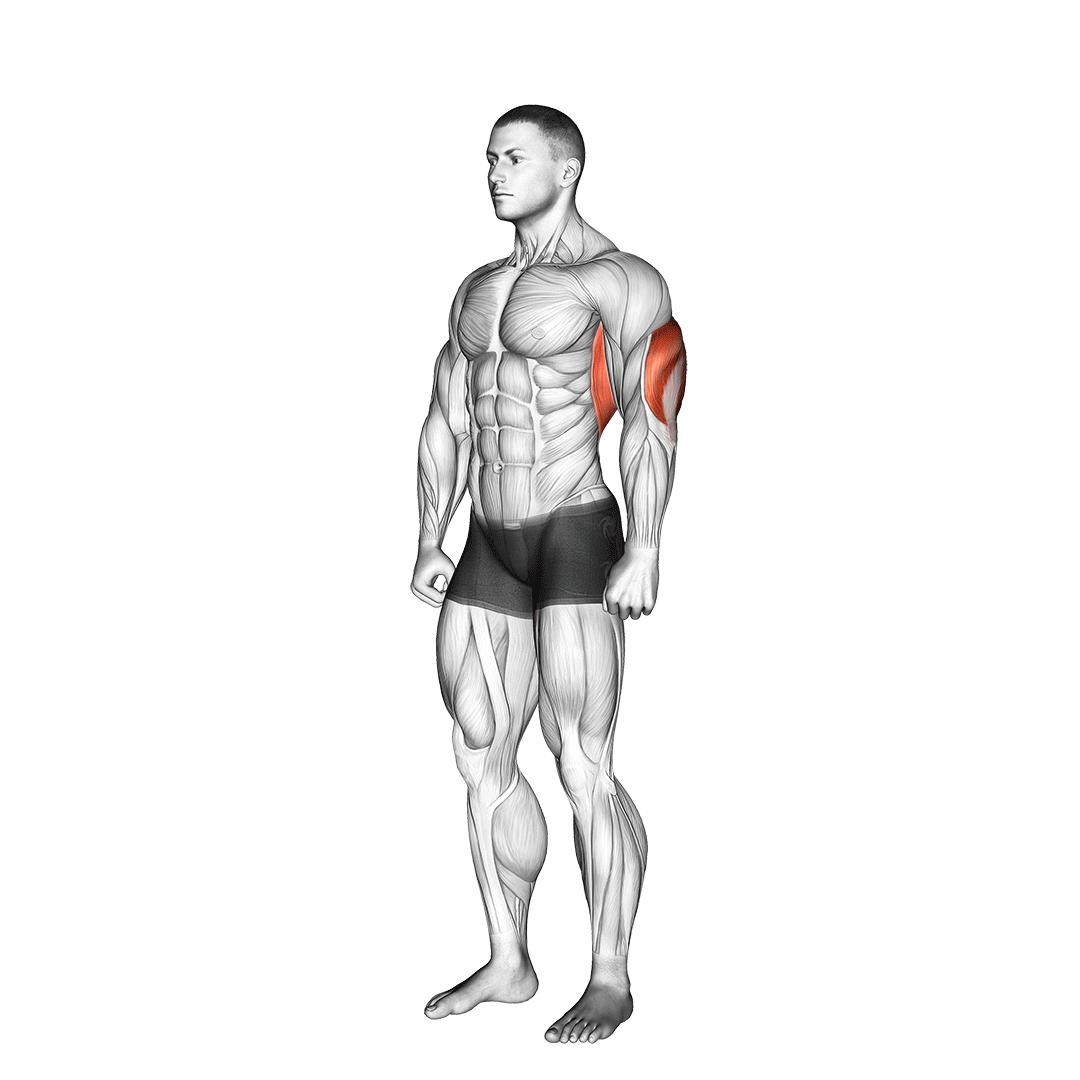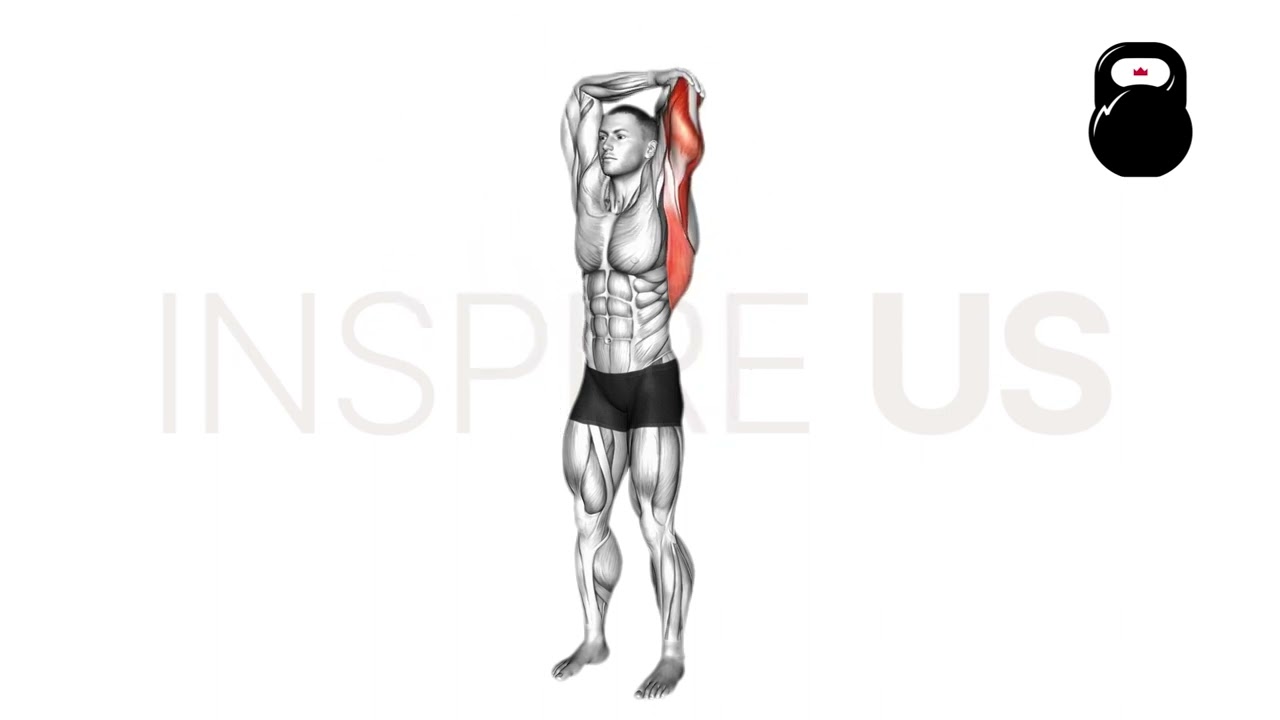Overhead Tricep Stretch: Benefits, Muscles Targeted, and More
The overhead tricep stretch is a basic static stretch known for its simplicity and convenience.
Quite literally involving stretching the triceps with the arm over the head, the overhead triceps stretch is most often seen prior to exercises involving some level of overhead arm extension. This includes the overhead press, basketball or handstand push-ups.
In this article, we will go over how to perform the overhead tricep stretch, its effects on nearby muscle and joints, as well as a few common mistakes to avoid.
What is the Overhead Tricep Stretch?
To describe it in detail, the overhead tricep stretch is a multi-joint static stretch involving external rotation of the shoulder and flexion of the elbow.

Exercisers have the choice of either pressing the elbow further down their back or otherwise grasping the opposite hand - both will help maximize the stretch’s range of motion.
Because overhead tricep stretches are classed as a static movement, they are more often used for cooling off after a workout, rather than as part of a pre-workout warm-up routine. This, of course, is in addition to general stretching done practically anywhere.
How to Do an Overhead Tricep Stretch
To perform an overhead tricep stretch, the exerciser will first begin by sitting or standing upright, one arm extended upwards.
Keeping the head facing forward and the shoulder of the raised arm relaxed, the exerciser then bends it at the elbow behind their head. The opposite hand will either press the bent elbow downwards or bend around the back so as to grip the hand of the bent arm.
Regardless of method, the opposite hand should apply pressure and draw the arm further down along the back. A stretch along the back of the upper arm should be felt.
From this point, the exerciser holds the stretch for up to 30 seconds before switching to the opposite arm.
What Muscles and Joints are Targeted by the Overhead Tricep Stretch?
The overhead tricep stretch will stretch out the entire triceps brachii, but maximize the length of the long head the most.

In addition, the anterior deltoids and the shoulder joint itself will also be partially affected by the stretch.
What are the Benefits of Doing the Overhead Tricep Stretch?
Apart from being generally beneficial to the mobility of the triceps, the overhead tricep stretch also offers the following benefits.
Emphasizes the Most Under-Stretched Portion of the Triceps
The majority of alternative triceps stretches will place greater emphasis on the lateral or medial head, rather than the long head.
This can lead to the long head becoming excessively tight and immobile, especially for individuals who regularly perform the bench press or push-up.
Fortunately, the overhead tricep stretch inverts this trend and instead emphasizes the long head. When performed correctly, the long head should be stretched to a nearly complete range of motion.
Excellent for Cooling Off After Push Day
Because both overhead extension mechanics and the triceps themselves are used during push day workouts, the overhead tricep stretch is the ideal cool-off exercise to aid in triceps recovery.
In particular, workouts involving exercises like the shoulder press, incline bench press or handstand push-up will all strain and compress the upper body in a manner that the overhead tricep stretch directly corrects.
Risk-Free and Extremely Simple
Unlike certain other types of stretch, the overhead tricep stretch is as simple as they come, and is largely free of injury risk. This makes the stretch excellent for both novices and for individuals just recently recovered from an injury.
Pairs Well With Behind-the-Back Biceps Stretches
Because of their similarity in stance and the proximity of the triceps to the biceps, pairing the overhead tricep stretch with a behind-the-back biceps stretch allows exercisers to target their entire arm and shoulder structure in only a minute.
Common Overhead Tricep Stretch Mistakes
While the overhead tricep stretch is indeed a simple exercise, there are a few common mistakes that are best avoided so as to take full advantage of its benefits.
Pushing the Upper Arm Past the Shoulder
A common mistake made when doing the overhead tricep stretch is pushing the elbow above and behind the shoulder joint, rather than towards the neck. This can strain the shoulder joint and otherwise make it difficult to actually stretch the triceps themselves.
For the best results, push the elbow to the side (towards the head), rather than backwards behind the torso.
Leaning the Torso Backwards
Curving the upper torso backwards during an overhead tricep stretch may reduce how far the triceps can be stretched as the shoulder joint reaches its terminal range of mobility.
In order to get the most out of an overhead tricep stretch, the torso should remain vertical with the upper back aligned over the hips. Those with trouble keeping their upper body oriented correctly may find benefit in performing the stretch from a seated position.
Turning the Head to the Side
Turning the head towards the arm being bent can also affect how far the triceps will be stretched by limiting the movement of the upper arm and shoulder.
To avoid doing so, it is best to keep the head aligned with the rest of the spine, and to ensure it is facing forwards.
Alternatives to the Overhead Tricep Stretch
If the overhead triceps stretch isn’t quite working the right section of the triceps, try the following alternatives out.
Horizontal Triceps Stretch
The horizontal triceps stretch can also be performed in a similar stance to its overhead counterpart. The main difference between the two lies in the direction of the arm, with the horizontal stretch having the lifter extend their arm across their torso.
Stretching the triceps in this manner better emphasizes the lateral and long head of the muscle group - although not to the same range as the overhead variation.
Triceps Towel Stretch
The triceps towel stretch is a more convenient form of overhead triceps stretch where both arms grip a towel behind the back.
The arm to be stretched will extend over the shoulder joint with the elbow close to the side of the head, whereas the opposite arm will pull the opposite end of the towel downwards from behind the waist.
The triceps towel stretch retains many of the same benefits as its towel-free counterpart, but also allows for a somewhat greater emphasis on the medial head of the triceps, depending on the angle of the humerus.
Frequently Asked Questions (FAQ)
What is the Best Tricep Stretch?
There is no one “best” tricep stretch, as each individual stretch features its own unique set of benefits. We suggest trying out both the horizontal and overhead triceps stretch to see which targets the stiffest section of your triceps.
What is the Overhead Tricep Stretch Used for?
The overhead tricep stretch is used to mobilize, stretch and drive blood flow to the triceps brachii and deltoids. When performed after a workout session, it is also used to aid in recovery.
Is the Overhead Tricep Stretch for Tricep Soreness?
Yes - static stretches like the overhead tricep stretch can help relieve symptoms of soreness after a bout of exercise. Combine a proper stretching routine with foam rolling or other forms of massage to maximize your relief.
Final Thoughts
The overhead tricep stretch is as useful as it is widely-practiced.
In combination with pectoral and deltoid stretches, they can be a veritable inclusion into any push muscle mobility routine.
If the overhead tricep stretch isn’t quite hitting the right part of your triceps, try out the triceps towel stretch or the horizontal stretch - both of which will allow you to target different tricep heads.
References
1. Fetters, K. Aleisha. My Pocket Guide to Stretching: Anytime Stretches for Flexibility, Strength, and Full-Body Wellness. United Kingdom: Adams Media, 2022. ISBN: 9781507217962, 150721796X

